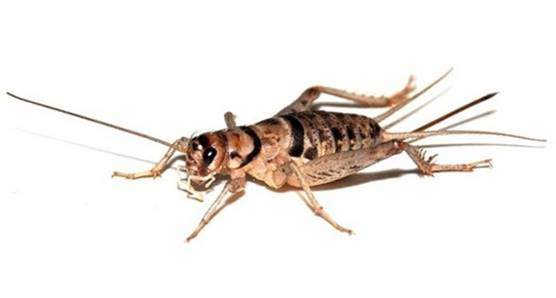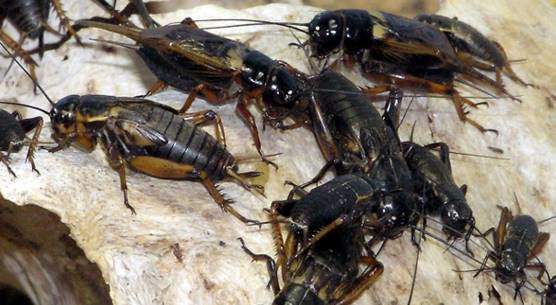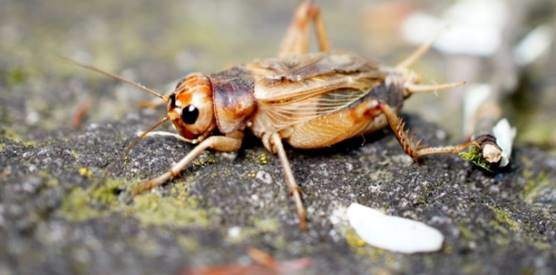Crickets (true crickets) are insects in the family Gryllidae, related to bush crickets (long-horned grasshopper or katydids) and distant relatives of grasshoppers with over 2400 different species with an average size of 3-5 cm in size.
While most of their species are leaping insects (flightless), some like the Gryllus assimilis can fly.
Finally, their males make a singing chirping sound, especially at night, and have a lifespan of about 8-10 weeks.
Common feeder crickets
The various type with the common ones being the field and house crickets, both of which are feeder insects to reptiles and amphibians. Here are the common types.
Gray or house crickets (Acheta domestica)
They are brownish or gray. They are prevalent feeder insects also edible by humans or kept may be as pets too in China and Japan. They are affected by the CrPV virus, a reason why some people in North America switched to other types, especially Gryllus assimilis.

Banded or tropical house crickets (Gryllodes sigillatus)
Also known as the Indian house or banded crickets, they are easier to care than black field or house crickets. Furthermore, they are active, live longer, are easier to digest (have less chitin), and are immune to the CrPV virus.

African, black, or Mediterranean field cricket (Gryllus bimaculatus)
Also, referred to as to common black or two-spotted cricket, they are a good option of insects for insectivorous reptiles and spiders since raising them is easy, and they can complete their lifecycle without being exposed too cold for a long time.

Common, silent or Jamaican crickets (Gryllus assimilis)
These silent or Jamaican field crickets are native to the southern United States, South America, and Mexico. However, they are available commercially in North America and Europe as feeder insects since they are immune to the CrPV virus
Unfortunately, they also flower vegetable gardens, and in citrus nurseries pets, a reason why you need to handle them properly.

Others
Others not commonly used as feeder insects are:
- Australian field crickets (Teleogryllus oceanicus) – They have a stripped head and black or dark brown colors.
- Fall field cricket (Gryllus pennsylvanicus) – They are common in Ontario and widespread in North America but not in the southwestern United States.
Note that Jerusalem, King, or giant weta (Mormon Cricket or Parktown Prawn), European or Roesel’s bush-cricket, among many others with the name are not true crickets.
Reasons for raising them
There are many reasons for keeping these feeder insects, which could be for your personal use or for sale to make a profit. They are some of the feeder insects in high demand.
Typical uses include bait such as fish bait as feeder insects for reptiles and amphibians such as chameleon, bearded dragons, snakes, turtles, tortoise, toads, salamanders, frogs, gecko, iguanas and so on or even spiders.
Also, they could be for your chicken, birds, or even for human consumption. If you are raising crickets for human consumption or as human food, then the edible ones are house crickets.
Finally, if you have a pet that eats them, instead of buying live crickets in bulk and storing them, you can breed and raise them. Doing so will save a lot of money, and you can start this venture with as little as $200, making it a cheap one.
Which ones to select?
We recommend the tropical house crickets Jamaican or African/Mediterranean field crickets are they are not vulnerable to CrPV virus. House crickets are also popular.
How to raise crickets
When it comes to keeping these insects, you need a well-ventilated holding tank, the right temperature, and humidity. Additionally, ensure you have a breeding dish, and you know how to feed and water them well.
Get a cricket keeper – tank or aquarium
You have a choice of buying or making it yourself. It should be durable, easy to clean, well ventilated, and secure. Also, it should protect them from cricket predators such as small snakes, rats, bats, shrews, mice, birds, centipedes, millipedes, salamanders, ants, wasps, spiders, mantids, lizards, ground beetles.
A plastic or glass tank is ideal. To calculate the tank size you need, you should know that one gallon can hold about 1000 crickets. The size you pick will depend on how many of these insects you are keeping. Go for smaller tanks if you want to raise a smaller colony and vice versa.
However, avoid overcrowding as it can cause cannibalism and death. A bigger container works better than a smaller one. For instance, you can go for a Rubbermaid or this large Durable Storage Box 24 Gal plastic containers. While it works well, an aquarium will be more costly.
In an ideal setup, you will need another to change these insects as you clean the other tank. Some people recommend buying containers for younger and adult crickets. However, it is not mandatory.
Finally, buying keepers such as Lee’s Kricket Keeper or Exo Terra Cricket Pen is not a good idea since they cannot hold a lot of these insects. They are ideal for keeping them after buying as you feed them to your pets.
Add egg flats or cartons
Place egg cartons or crates (stacked horizontally or vertically), egg cardboard flats, toilet paper rolls, to more personal provide space, security, climb or hide. The egg trays must be safe in case they decide to eat them, and they can cover up to 3 quarters of the space.
The remaining space can be for waterers, feeding bowls and nesting or breeding dishes. Avoid adding any substrate on the floor as it can cause a foul odor.
In case you use one, go for vermiculite as it may reduce any odor and replace it after one to a few months. However, using vermiculite will require you to have a screen prevent your crickets from laying eggs in vermiculite as retrieving them will be hard.
Keep the right humidity and ventilation
Humidity for adults can be at 50%, while pinheads and adolescent crickets need a more humid area at 50-70%. A massive rise will not only kill these insects but also promote mold growth on egg trays
Besides keeping the right humidity, proper ventilation is necessary to help reduce odor. Therefore, don’t cover the tank. Instead, place a securely held metallic mesh on top of your container to stop them from leaping out. Avoid nylon or fiberglass screens as they may eat them up.
Keep the right temperature
For them to breed and thrive, these critters need a temperature of between 75 – 90 degrees Fahrenheit. The temperatures should never fall below 70 degrees Fahrenheit as it will cause cannibalism or death, while if it goes above 95 degrees Fahrenheit, it will shorten their lifespan.
Keeping young ones at temperatures of 80 to 90 degrees Fahrenheit will spur faster growth while maintaining a lower temperature will slow down growth.
Since they love dark places, a black or ceramic heat emitter such as the one used in heating reptile tanks will be ok together with a thermostat and a thermometer for checking the temperature.
A heater is only necessary if your ambient temperature is way below 70 degrees Fahrenheit. Otherwise, don’t use it.
Breeding dish
One female cricket lay about 5-10 eggs a day and up to 100 eggs in her lifespan, from this, you can estimate the number to buy as you start your colony.
Ensure you give them a small dish for laying eggs. Fill this dish with dirt free of any chemicals, peat moss, sand, vermiculite, coconut fiber, and add some water to make the substrate wet but not soaked. A two-inch deep plastic dish will work well. Include a ramp up for easy climbing.
To know if they have laid eggs, check inside in the breeding dish for eggs, usually buried about a half an inch into your substrate. If you see eggs, remove this breeding dish for incubation at 89 degrees Fahrenheit for 8-10 days and place another breeding dish in case some want to continue laying more eggs.
Afterward, you will notice them hatching. During incubation, until the eggs hatch, keep the breeding dish with eggs moist all the time.
Once they hatch, collect pinheads and take them to their habitat or a separate one once they hatch to make grading them according to sizes easy if you want to sell them. However, give the pinheads up to 7 days if you are returning them to the same container if it has older crickets.
Alternatively, you can buy the Cricket Colony Starter Kit, which has five egg flats, a pound of cricket food, an ounce of water gel, soil and soil container, vermiculite to absorb urine and feces, a spray bottle for keeping the keeper’s environment humid and moist.
There is also a Nature Zone Cricket Breeding kit. However, most users are not so happy with this particular kit.
What and how to feed them?
In the wild, crickets eat fruits, leaves, flowers, seedlings, grasses, shoots of young plants while some species are predatory, and they add on eat live or dead insects, grasshopper eggs, flies, butterflies, moth pupae and so on to their diet.
In captivity, you need to give them dry foods, veggies, or greens as well as fruits. Common ones include the following:
- Dry foods: Wheat bran, wheat flakes, corn flakes, bran flakes, dry milk powder, unsalted nuts such as peanuts, almond nuts, alfalfa pellets, fish flakes, or sunflower seeds, etc.
- Veggies and greens: Romaine lettuce, collard greens, mustard greens, dandelion greens, broccoli, as well as carrots, potatoes, among others. They are useful in gut-loading them too.
- Fruits: Apples, grapefruits, berries, watermelons, mango, papaya, orange, banana, amongst many other safe ones.
- Other Foods: You can also give them pulverized cat food, dog food or chicken feed, mixed seeds and nuts, and you can add calcium supplements for reptiles.
Finally, you can go for commercial cricket foods, which are nutritionally balanced and will ensure you have the healthiest crickets, especially if you are doing large-scale farming. Some of the quality brands include:
- Fluker’s Orange Cube Complete Cricket Diet
- Josh’s Frogs Cricket Food
- Fluker’s High Calcium Cricket Feed, 6-Pound
- Pangea Roach and Cricket Food
Finally, remove any uneaten food before it spoils, but do not waste any food that is still fresh. Also, put their food in one place to minimize it, mixing with their feces or wetting egg cartons as this will encourage mold growth.
Watering them
These insects need water. When providing them with drinking water, put it in a shallow dish with a sponge or piece of potato to create an island to avoid drowning, and use dechlorinated water.
Besides fresh veggies, fruits such as watermelon, oranges, and potatoes may help keep these feeder insects hydrated.
Finally, there are commercial hydrating gels, some of which are fortified with calcium and other minerals that will prevent drowning. Good ones include;
- Fluker’s Cricket Quencher
- Nature Zone SNZ54212 Water Bites Food with Calcium for Crickets
- Zilla Gut Load Cricket Drink
Ordering first batch
Usually, these insects begin to procreate when they are 1-2 weeks old. Order those that are about 3/4” and not adults as the latter may have bred before they went on sale. When you hear them chirping, they are about to begin producing, and they need their breeding dish or a place to lay eggs.
It is a good idea to buy more females than males. You can start with a batch of 30-50 crickets. Females have an unpaired thin ovipositor projecting backward from their cerci. If they do not have an ovipositor, they are male.
Cleaning cricket cages or tanks
Once you receive your first colony, besides feeding and watering them, you need to keep their keepers very clean.
When cleaning, you can either scoop these insects or their poop. Move these insects will move with these egg carton trays, scoop the dirt, slide it back, and scoop the other side.
Additionally, do real disinfection and cleaning once or twice monthly to help any eliminate odors. This thorough cleaning will be more effective if you move everything from the keeper to a temporary place.
As you move them, be careful not to kill pinhead crickets as they are still tiny and fragile or begin with a clean tank before they hutch.
While cleaning the cages, use dilute bleach, rinse and dry them before returning your crickets, Avoid the use of pesticides or detergents.
Handling and capturing them
To move them, do so while they are in their egg cartons and be swift. Alternatively, place tubes inside their tank and let them climb them into them to hide. Afterward, shake these pipes to get out the number you need.
Crickets for sale
Success in cricket raising for commercial sale requires you to consider hygiene and biosafety and their health. You do not want to sell those that are not well fed or are sick such as with cricket virus.
Furthermore, you will need to have more containers or tanks to keep them so that you can grade them according to sizes. Standard sizes sold are:
- Pinheads – 1-2 days old
- ¼ of an inch- about seven days old
- ½ of an inch – Around three weeks old
- ¾ of an inch – 4 weeks of age
- 1 inch – 5 weeks and above
To sell them target bait shops, people who eat them or use them as feeder insects. You will not miss pet stores, bait stores, people online willing to buy them. Additionally, advertise them in your local magazines, craigslist, or on your blog.
Once you get customers, you need to decide on a method of delivering these insects to your customers. You can use FedEx overnight priority, FedEx second day, FedEx Home Delivery, USPS Priority Mail, airmail, and so forth.
Package these insects well to ensure they remain alive and give them something to eat and stay dehydrated while on transit, primarily commercial foods.
Usually, you need to ship them in lightweight boxes with egg trays and a screen glued on one side. If it is cold, go for blind boxes, and if it is freezing, add heat packs, especially in winter.
Finally, price them well, given some guarantees in case they die while under shipment, such as sending another batch.
The downside of keeping crickets
While they are an excellent feeder insect, you deserve to know they are noisy, i.e., they chirp. Place their breeding or keeping tank away from your living area.
Furthermore, they have an odor. People who have never spent time with them will quickly notice. However, the use of the vermiculite substrate may be helpful but will require you to change it regularly. It will also control odor and bacterial growth.
Besides vermiculite substrate, ensure they have proper ventilation as this will help minimize odor too.
Since they leap or jump, ensure their tank you cover their keeper with a screen always. You don’t want to deal with the hustle or stress of trying to capture them should they escape.
Finally, at times, they may die. Death can be due to drowning, wrong temperature, little space, poisoning, diseases, or poor handling, especially pinheads.
